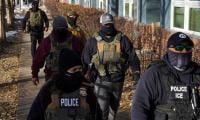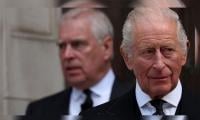Who is killing us?
Elsewhere grief unites. Here it divides. Sorrow makes nations reflective. Here it breeds more conflict. When flags fly half-mast, those in power bow their heads in shame. In Pakistan, it becomes an occasion to fake success and make new claims. When systems fail, wielders of authority accept responsibility, and –
By Syed Talat Hussain
May 18, 2015
Elsewhere grief unites. Here it divides. Sorrow makes nations reflective. Here it breeds more conflict. When flags fly half-mast, those in power bow their heads in shame. In Pakistan, it becomes an occasion to fake success and make new claims. When systems fail, wielders of authority accept responsibility, and – the more honourable among them – choose to go. In this land, it becomes an opportunity to pass around culpability so that everyone could stay – just a little longer.
Be it the Army Public School massacre or last week’s blood-bath in Karachi, the pattern remains the same. They come, unhindered. We baulk, hand-tied. They kill without mercy. We chill without shame. They follow up with more terror. We follow up with more tweets.
This is why we – a nation that has lost more blood, sweat and money in combat in the past two decades than any other on earth – are where we are today: still talking about ‘efficient policing’, ‘more check-posts’, ‘better intelligence’, ‘better coordination’ and other such sweet sounding terms that actually are a way to say: ‘we, standing at ground zero, are still grappling with the basics’.
Going purely by results so far, the so-called National Action Plan stands for Nothing Action Plan. The mantra of slow and steady progress is just so much tosh. This entire document was meant to create a response that was comprehensive, simultaneous, robust and above all swift and result-oriented. By now it should have had terror networks, and not the public, across the country running for cover. It should have sown fear in the hearts of our enemies rather than traumatise the minorities and the majority alike. It should have been effective and reassuring rather than becoming a sorry sight of endless meetings that yield little except the stale demand of ‘national unity’ and sickening photo-ops.
But the larger point of worry is not that we haven’t figured out a system, a strategy, a radically energised and well-rooted programme that works mini miracles on ground every day; it is that we are unable to characterise the nature of threat and even more significantly its origin.
We continue to insist on ‘fighting terrorism’. Terrorism, like aerial bombing, drone attacks, sabotage, guerrilla warfare etc, is a tactic. It is a tool. You don’t fight tools. You don’t fight tactics. You fight those using these tools and tactics. So who is using them? Terrorists obviously. And who exactly are these terrorists, where do they come from, who trains them, gives them equipment, direction, command, motivation and such consistency of performance that every time they venture out they hit the bull’s eye?
Pose these questions to anyone in policymaking machinery and get ready to be massively surprised. You will either get a non-answer or so many answers that your head will spin. In the first instance vagueness is mindboggling; in the second, the breadth of possibilities. But in both cases, the result is the same: we cannot boil it down to the source of terror.
Karachi, like Fata, is a spectacular case study in this regard. Take the Safoora incident. The vague part of the answer to the question, ‘Who is behind such grisly attacks?’, is a standard line: We are working on some leads we have and soon we will reveal the mastermind. (The mastermind of course is never caught or revealed, state-managed revelations on the media for domestic audience by hardened criminals regardless.)
The too-many-answers part of the response suggests at least six potential sources of such attacks and killing sprees. One, a political party with terror wings is trying to create a diversion by killings that look like the work of religious fanatics so that the focus shifts from their deeds to fictional fundamentalists. Two, extremist groups with hateful ideology and murderous intent are targeting minorities because they want to impose their benighted ideas on Quaid’s Pakistan. Three, it is RAW that is using terror through proxies to create instability and destruction inside the country. Four, it is a blow-back of Operation Zarb-e-Azb that has dismantled terror networks (successfully of course) from Fata and these desperate groups are now trying avenge their losses. Five, Islamic State or Daesh is laying roots here and wants to make a strong and deadly statement of its arrival. Six, it is the Chinese Corridor that big global players want to sabotage by sending a message of hopelessness and internal meltdown. Now this is quite a list.
Along with this bewildering array of ‘likelihoods’ is hooked no less a dazzling line of combinations: RAW plus local political groups; Foreign powers plus local extremist groups; One extremist group plus another extremist group; Old extremist groups plus new extremist groups. A bit like a shaken kaleidoscope producing endless fantastic patterns, official analyses of the hands behind killings conjure up no clear picture. It can be some of these groups or combinations, one of them, most of them, all of them. With such clutter on the radar, the way ahead – another over-used term – cannot be found.
As any basic research on successful counterterrorism measures anywhere in the world would reveal, long before states lunge into catching and punishing miscreants, they trace them to their roots and know how to uproot them. They don’t jump in the dark and then attempt to gear up efforts mid-flight. Above all, they know who to get and from where. They don’t guess around.
Contrary to the convenient myth that counterterrorism is an effort without end – which Bushites had invented to justify their power agendas, and which we embraced with our eyes closed – restoring order, stamping out illegal groups and catching killers are goals with deadlines. There are performance indicators that measure success and failure. There are mechanisms of accountability that kick in each time a deadline is unmet, a goal is un-achieved, a gain is reversed, a plan has collapsed.
And all of this is tied to total clarity about the main aim of all efforts: those unleashing terror. Without unequivocally and officially identifying terror groups behind such events, without explaining how they operate and what is their shape, size and scope of work, without marking their leaders and their henchmen and support network, countering terrorists will remain a wild goose chase.
This country has given everything to those in power. They have votes, money, mandate, authority. Let us give them further confidence by saying that General Raheel Sharif is the best commander the Aubcontinent has seen in the last one hundred years. That Prime Minister Nawaz Sharif is the most visionary man who has walked this land after Quaid-e-Azam. That Imran Khan is a godsend liberator, the sort that has not been seen for centuries. That the PPP is the finest thing that has happened to the poor. That the MQM is a true voice of the middle class. That the Jamaat-e-Islami is the vanguard of religion. That all our chief ministers are award-winning performers. That the judges are all knowing, truly honourable and the media is the pits. That the nation stands united and will eat grass to cough up resources needed to fight the war.
With this out of the way, can we now find out exactly who is killing us, why they are killing us and when will they stop killing us? Please?
The writer is former executive editor of The News and a senior journalist with Geo TV.
Email: syedtalathussain@gmail.com
Twitter: @TalatHussain12
Be it the Army Public School massacre or last week’s blood-bath in Karachi, the pattern remains the same. They come, unhindered. We baulk, hand-tied. They kill without mercy. We chill without shame. They follow up with more terror. We follow up with more tweets.
This is why we – a nation that has lost more blood, sweat and money in combat in the past two decades than any other on earth – are where we are today: still talking about ‘efficient policing’, ‘more check-posts’, ‘better intelligence’, ‘better coordination’ and other such sweet sounding terms that actually are a way to say: ‘we, standing at ground zero, are still grappling with the basics’.
Going purely by results so far, the so-called National Action Plan stands for Nothing Action Plan. The mantra of slow and steady progress is just so much tosh. This entire document was meant to create a response that was comprehensive, simultaneous, robust and above all swift and result-oriented. By now it should have had terror networks, and not the public, across the country running for cover. It should have sown fear in the hearts of our enemies rather than traumatise the minorities and the majority alike. It should have been effective and reassuring rather than becoming a sorry sight of endless meetings that yield little except the stale demand of ‘national unity’ and sickening photo-ops.
But the larger point of worry is not that we haven’t figured out a system, a strategy, a radically energised and well-rooted programme that works mini miracles on ground every day; it is that we are unable to characterise the nature of threat and even more significantly its origin.
We continue to insist on ‘fighting terrorism’. Terrorism, like aerial bombing, drone attacks, sabotage, guerrilla warfare etc, is a tactic. It is a tool. You don’t fight tools. You don’t fight tactics. You fight those using these tools and tactics. So who is using them? Terrorists obviously. And who exactly are these terrorists, where do they come from, who trains them, gives them equipment, direction, command, motivation and such consistency of performance that every time they venture out they hit the bull’s eye?
Pose these questions to anyone in policymaking machinery and get ready to be massively surprised. You will either get a non-answer or so many answers that your head will spin. In the first instance vagueness is mindboggling; in the second, the breadth of possibilities. But in both cases, the result is the same: we cannot boil it down to the source of terror.
Karachi, like Fata, is a spectacular case study in this regard. Take the Safoora incident. The vague part of the answer to the question, ‘Who is behind such grisly attacks?’, is a standard line: We are working on some leads we have and soon we will reveal the mastermind. (The mastermind of course is never caught or revealed, state-managed revelations on the media for domestic audience by hardened criminals regardless.)
The too-many-answers part of the response suggests at least six potential sources of such attacks and killing sprees. One, a political party with terror wings is trying to create a diversion by killings that look like the work of religious fanatics so that the focus shifts from their deeds to fictional fundamentalists. Two, extremist groups with hateful ideology and murderous intent are targeting minorities because they want to impose their benighted ideas on Quaid’s Pakistan. Three, it is RAW that is using terror through proxies to create instability and destruction inside the country. Four, it is a blow-back of Operation Zarb-e-Azb that has dismantled terror networks (successfully of course) from Fata and these desperate groups are now trying avenge their losses. Five, Islamic State or Daesh is laying roots here and wants to make a strong and deadly statement of its arrival. Six, it is the Chinese Corridor that big global players want to sabotage by sending a message of hopelessness and internal meltdown. Now this is quite a list.
Along with this bewildering array of ‘likelihoods’ is hooked no less a dazzling line of combinations: RAW plus local political groups; Foreign powers plus local extremist groups; One extremist group plus another extremist group; Old extremist groups plus new extremist groups. A bit like a shaken kaleidoscope producing endless fantastic patterns, official analyses of the hands behind killings conjure up no clear picture. It can be some of these groups or combinations, one of them, most of them, all of them. With such clutter on the radar, the way ahead – another over-used term – cannot be found.
As any basic research on successful counterterrorism measures anywhere in the world would reveal, long before states lunge into catching and punishing miscreants, they trace them to their roots and know how to uproot them. They don’t jump in the dark and then attempt to gear up efforts mid-flight. Above all, they know who to get and from where. They don’t guess around.
Contrary to the convenient myth that counterterrorism is an effort without end – which Bushites had invented to justify their power agendas, and which we embraced with our eyes closed – restoring order, stamping out illegal groups and catching killers are goals with deadlines. There are performance indicators that measure success and failure. There are mechanisms of accountability that kick in each time a deadline is unmet, a goal is un-achieved, a gain is reversed, a plan has collapsed.
And all of this is tied to total clarity about the main aim of all efforts: those unleashing terror. Without unequivocally and officially identifying terror groups behind such events, without explaining how they operate and what is their shape, size and scope of work, without marking their leaders and their henchmen and support network, countering terrorists will remain a wild goose chase.
This country has given everything to those in power. They have votes, money, mandate, authority. Let us give them further confidence by saying that General Raheel Sharif is the best commander the Aubcontinent has seen in the last one hundred years. That Prime Minister Nawaz Sharif is the most visionary man who has walked this land after Quaid-e-Azam. That Imran Khan is a godsend liberator, the sort that has not been seen for centuries. That the PPP is the finest thing that has happened to the poor. That the MQM is a true voice of the middle class. That the Jamaat-e-Islami is the vanguard of religion. That all our chief ministers are award-winning performers. That the judges are all knowing, truly honourable and the media is the pits. That the nation stands united and will eat grass to cough up resources needed to fight the war.
With this out of the way, can we now find out exactly who is killing us, why they are killing us and when will they stop killing us? Please?
The writer is former executive editor of The News and a senior journalist with Geo TV.
Email: syedtalathussain@gmail.com
Twitter: @TalatHussain12
-
 Jennifer Aniston, Jim Curtis Face One Major Hurdle In Their Union
Jennifer Aniston, Jim Curtis Face One Major Hurdle In Their Union -
 Restaurant Workers Detained After ICE Agents Dine At Minnesota Eatery
Restaurant Workers Detained After ICE Agents Dine At Minnesota Eatery -
 Kate Middleton Reveals Sport She Would Not Play With Prince George
Kate Middleton Reveals Sport She Would Not Play With Prince George -
 First Poll Since King Charles' Action Against Andrew Reveals Royal Family's Public Standing
First Poll Since King Charles' Action Against Andrew Reveals Royal Family's Public Standing -
 Blake Lively Strengthens Legal Team Ahead Of Justin Baldoni Trial
Blake Lively Strengthens Legal Team Ahead Of Justin Baldoni Trial -
 'Back To School!': Palace Shares Details Of Princess Anne's Latest Engagements
'Back To School!': Palace Shares Details Of Princess Anne's Latest Engagements -
 Paul Mescal Clarifies Acting Break Comment As He Teases Paul McCartney Role
Paul Mescal Clarifies Acting Break Comment As He Teases Paul McCartney Role -
 Kate Middleton's Unexpected Style Of Arrival At Solo Outing Goes Viral
Kate Middleton's Unexpected Style Of Arrival At Solo Outing Goes Viral -
 Why ‘X’ Is Down? Thousands Report Twitter Outage: Here’s What You Can Do
Why ‘X’ Is Down? Thousands Report Twitter Outage: Here’s What You Can Do -
 Florida Man Held After Alleged Nail-scattering On Busy Intersections
Florida Man Held After Alleged Nail-scattering On Busy Intersections -
 Valeria Nicov: Sean Penn's Athletic Girlfriend Raises Eyebrows With Latest Photos
Valeria Nicov: Sean Penn's Athletic Girlfriend Raises Eyebrows With Latest Photos -
 Sharon Stone Lashes Out At Fellow Award Show Attendees After Stealing Accusations
Sharon Stone Lashes Out At Fellow Award Show Attendees After Stealing Accusations -
 Gwyneth Paltrow Reveals Real Reason She Said Yes To 'Marty Supreme'
Gwyneth Paltrow Reveals Real Reason She Said Yes To 'Marty Supreme' -
 King Charles Says He And Queen Camilla Stand With People Of Ukraine
King Charles Says He And Queen Camilla Stand With People Of Ukraine -
 Ben Affleck Argues In Favour Of His Shirtless Scene In 'The Rip'
Ben Affleck Argues In Favour Of His Shirtless Scene In 'The Rip' -
 Mississippi Postal Worker Arrested After Complaints Of Marijuana Odour In Letters
Mississippi Postal Worker Arrested After Complaints Of Marijuana Odour In Letters



